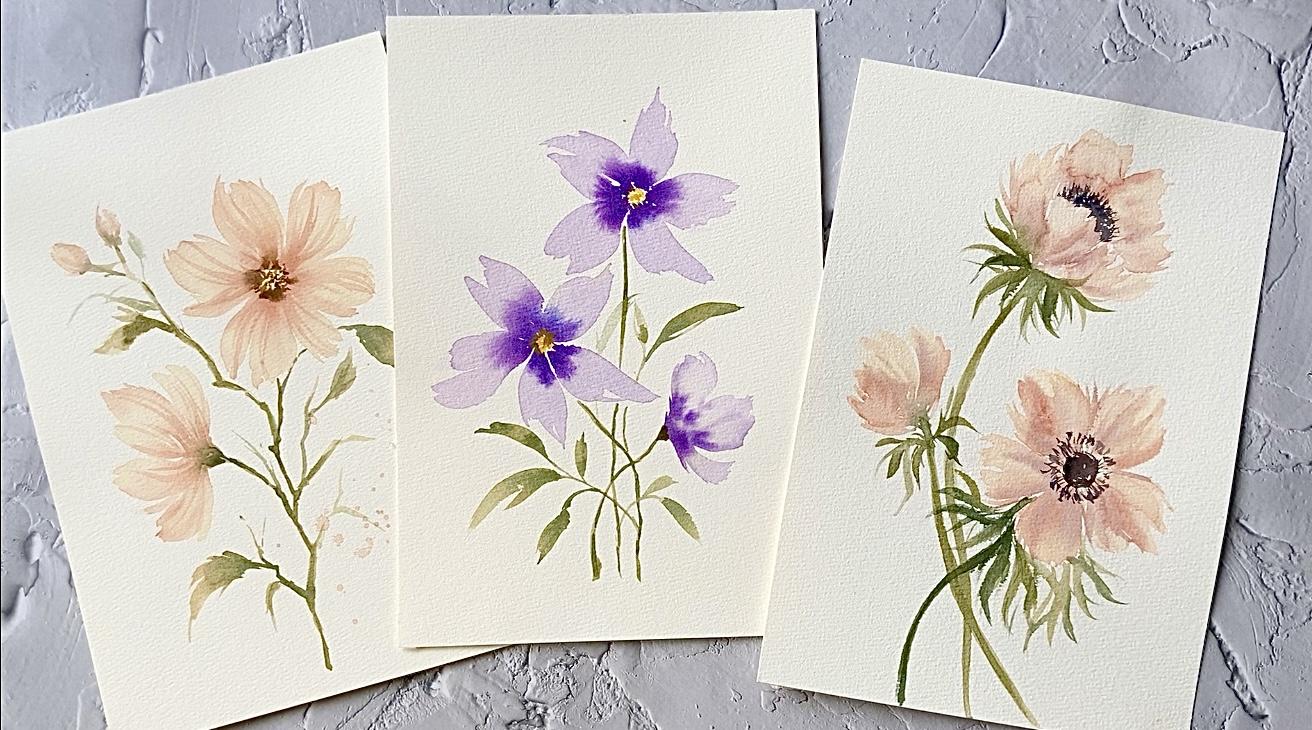Watercolor flowers are dreamy, expressive, and surprisingly easy once you know a few essential techniques. Whether you’re a total beginner or someone who wants to sharpen your artistic skills, this guide reveals the secret to watercolor flowers paintings—from materials and brush control to color blending and composition.Let’s unlock the magic behind soft petals, smooth blending, and elegant floral designs!🌸 1. Choose the Right Watercolor SuppliesUsing proper supplies makes a MASSIVE difference in watercolor art.✔ Paper (most important!)Use at least 140 lb (300gsm) watercolor paper.Hot press → smooth (good for fine details)Cold press → textured (best for flowers)✔ PaintYou can use pans or tubes. Choose:Student-grade for practiceArtist-grade for vibrant, blendable colors✔ BrushesMust-haves:Round brush size 6–10 (for petals)Fine detail brush (for stems & lines)Mop brush (for washes)✔ Other essentialsMixing paletteTwo water jarsPaper towelPencil (for light sketches)Good supplies = smoother blending and better control.🌺 2. Master the Watercolor “Secrets”⭐ Secret #1: Water Control = EverythingToo much water? Colors bleed uncontrollably.Too little? The paint looks dull.Practice:wet-on-wetwet-on-drydry-brush techniquesThis is the TRUE foundation of watercolor flowers.⭐ Secret #2: Use Simple ShapesFlowers look complex, but they start as:teardrop shapescirclesovalscurved strokesLearning these shapes makes painting flowers easier and consistent.⭐ Secret #3: Layering Creates DimensionWatercolor is transparent—this is your superpower.Start with light colorsLet dryAdd darker detailsThis creates realistic, soft petals.⭐ Secret #4: Color Mixing Makes Flowers PopSkip using colors straight from the palette.Mix variations of:pinkspurpleswarm yellowscool greensA little variation adds natural beauty.🌼 3. Easy Step-by-Step Watercolor Flower Techniques🌸 A. Loose Watercolor Flowers (Beginner-Friendly)This style is popular because it’s effortless and expressive.Steps:Load your brush with watery paint.Paint 5–6 soft petal shapes in a circle.Add darker color in the center while still wet.Let dry.Add thin, light stems and leaves.Great for:cardsjournalswall art🌹 B. Watercolor Roses (Intermediate)The secret to roses: spiral + layered petals.Steps:Start with a soft spiral center.Add C-shaped strokes around it.Expand petals outward, leaving some white gaps.Deepen the center with a darker shade.Add loose leaves.🌻 C. Sunflowers (Bold & Bright)Steps:Paint a circular brown center.Use loose strokes around it for petals.Mix golden-yellow + orange.Add dark spots to the center once dry.🌺 D. Lavender (Super Easy)Steps:Paint a thin stem.Dab your brush upward in clusters.Use 2–3 shades of purple for realism.Great for beginners!🌿 4. Adding Leaves & Greenery (The Secret Finishing Touch)Beautiful leaves make your flowers look polished.Tips:Use the press-and-lift techniqueVary greens: mix yellow, blue, and a little redAdd movement: curve stems and leavesUse darker greens for shadowsLeaves should feel airy and natural—not stiff.🎨 5. Composition Tips for Stunning Floral ArtYour arrangement makes all the difference!✔ Rule of 3Paint flowers in odd numbers: 3, 5, 7.✔ Create FlowUse curved stems that lead the eye.✔ Mix Sizes1–2 main flowerssmall filler flowersloose greenery✔ White Space Is Your FriendDon’t overfill the page. Let your painting breathe.🌈 6. Color Palette Ideas for Watercolor Flowers🌸 Soft & RomanticRose pinkBlushPale purple🌺 Bold & DramaticCrimsonBurgundyMustard yellow🌿 Nature-InspiredOlive greensSageDeep forest tones🌼 Spring FreshLemonPeachLight lavenderMatching your colors gives your floral art a cohesive look.✨ 7. Common Mistakes & How to Fix Them❌ Overworking the paintingFix: Use fewer strokes and let water do the blending.❌ Muddy colorsFix: Don’t mix too many pigments at once.❌ Petals too stiffFix: Vary petal shapes and leave white gaps.❌ Harsh edgesFix: Soften with a clean, damp brush.❌ Colors fadingFix: Add a second or third layer after drying.🔥 8. Pro Secrets to Level Up Your Watercolor FlowersPaint lightly first, detail laterUse multiple water containers (clean vs. dirty water)Tilt your paper to let colors bleed naturallyAdd splashes for artistic effectsCombine ink + watercolor for modern floralsUse masking fluid for preserved white highlightsStudy real flowers for shape and shading inspirationThese small tricks transform your artwork instantly!🌸 Conclusion: Learn the Secret to Watercolor Flowers PaintingsCreating beautiful watercolor flowers isn’t about talent—it’s about understanding water control, layering, color mixing, and simple shapes. Once you master these core secrets, your floral paintings will bloom with life, softness, and vibrant emotion.Whether you want to paint roses, daisies, lavender, tulips, or loose florals, this guide gives you everything you need to get started—and improve fast.

